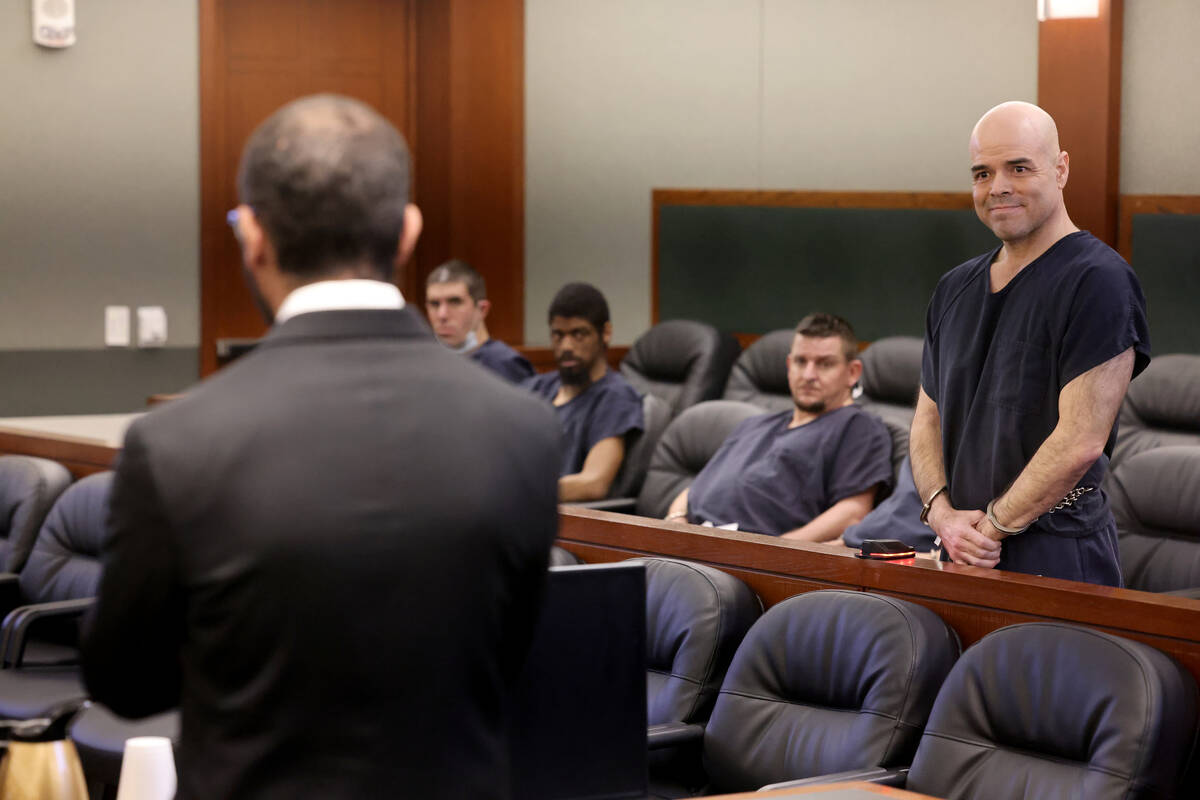Prosecutors expected to argue ‘overwhelming’ case against suspect in reporter’s slaying
There are no eyewitnesses to the slaying of Las Vegas Review-Journal investigative reporter Jeff German.
But experts say there is still enough evidence for prosecutors to prove a strong case against the suspect, a former low-level elected official accused of killing German over articles the journalist wrote about his conduct.
The circumstances of the case paint a relatively clear picture against former Clark County Public Administrator Robert Telles, said David Roger, former Clark County district attorney.
“You may not have all the pieces to the puzzle, but if you have enough of the pieces, you can see what the puzzle is,” Roger said. “You may miss a piece here and there, but the circumstances, the entire picture of the jigsaw puzzle, is sufficient enough to show what the photograph is. And it’s the same thing with circumstantial evidence cases.”
Shortly after Telles was arrested, Chief Deputy District Attorney Christopher Hamner said in court that the evidence against Telles was “overwhelming.” It’s a stance that prosecutors have maintained over the past two years, as their court documents have referenced Telles’ DNA found underneath German’s fingernails, surveillance footage and cut-up pieces of physical evidence.
RELATED: Telles clashed with real estate firm before claiming he was framed for murder
Hamner and Chief Deputy District Attorney Pamela Weckerly, both longtime homicide prosecutors, are set to begin trial on Monday against Telles and his defense attorney, Robert Draskovich.
Clark County District Attorney Steve Wolfson declined to give an interview about the case for this article.
“I don’t want to do anything to taint this trial at all,” Wolfson told the Review-Journal.
DNA evidence
German, 69, was killed on Sept. 2, 2022. He was stabbed multiple times in the neck and torso, authorities said, when he confronted a man outside his home near Summerlin.
A neighbor discovered German’s body the next day and called 911, triggering an investigation that ended on Sept. 7, 2022, with Telles’ arrest. Telles has remained in custody without bail since, and has maintained that he was framed for the killing.
Before identifying Telles, police collected video surveillance and gathered forensic evidence from German’s body. Once officials detained Telles days later — after executing search warrants at his home and receiving tips that he was angry with German — it took the results of a DNA analysis for Telles to be arrested.
Wolfson has previously said it was the DNA results that solidified the choice to charge Telles with the killing of the longtime Las Vegas journalist.
“I was notified of the forensic evidence finding of the DNA, and yes I thought it was appropriate to arrest Mr. Telles at that point,” Wolfson told reporters the day after Telles was arrested.
Roger said he could see no explanation that Telles’ defense could give to explain away the DNA found underneath German’s fingernails.
“That DNA evidence is very, very strong, because it’s clear that Jeff was fighting for his life,” the former district attorney said. “He probably was able to scratch or at least have some physical contact with Telles.”
Draskovich acknowledged the case’s DNA evidence when speaking with reporters days before the trial was scheduled to begin.
“That will present a problem with the defense in this case,” he said. “But again, that’s what trials are for.”
After Telles was arrested, police noted bruises and cuts on his hands. One cut on his finger had been superglued shut, according to copies of search warrants. Telles told detectives that he hurt his finger cutting food the night before, but Roger said a prosecutor could argue that the assailant likely cut himself while attacking German.
Defense attorney Christopher Oram, who frequently goes to trial on murder cases, said that if the only evidence against Telles were DNA, he might be able to argue that human error or evidence cross-contamination tainted the results. But when the DNA analysis is compared with the rest of the case’s evidence, it becomes much harder for an attorney to defend every aspect of the case.
“The more things you have to counter, the more problematic it becomes,” Oram said.
Telles has long pushed for his day in court and has opposed delays in the trial. Oram said if Telles wants to take the stand during the trial, it could help the prosecution’s case. He would face cross-examination from experienced prosecutors and would have to explain multiple pieces of circumstantial evidence.
Oram said a defendant testifying in his own trial runs the risk of sounding “ridiculous” to a jury.
Surveillance footage
The assailant in German’s murder was careful to obscure his identity.
Days after German was killed, police released an image of a man walking through German’s neighborhood in a reflective vest and tennis shoes, carrying a duffel bag and wearing a large straw hat. The car he drove, a maroon GMC Yukon Denali, had no license plate when he parked it near German’s home, according to court records.
When police later searched Telles’ home, they found multiple pieces of evidence seemingly connected to the suspect in the surveillance footage.
Underneath Telles’ couch, a plastic bag contained cut-up pieces of tennis shoes. In the garage, a reusable shopping bag held cut-up pieces of a large straw hat. And stuffed inside a toolbox was a gray duffel bag, similar to the one carried by the suspect.
Both the shoe pieces and a pair of scissors in Telles’ home had blood on them, according to court transcripts.
After releasing images of the Yukon Denali and the man in German’s neighborhood, police began receiving tips that Telles was angry with German’s reporting. Months before, German reported on allegations that Telles had created a toxic work environment at the public administrator’s office, and was engaged in an “inappropriate relationship” with another staffer.
Investigators found that Telles’ wife, Mary Ismael, had a maroon GMC Yukon Denali registered in her name. Copies of search warrants show that the suspect’s vehicle had similar characteristics to Ismael’s car — a chrome package, running boards and no tint on the front windows.
Neighborhood surveillance footage showed that a Yukon Denali left Telles’ neighborhood just before 9:15 a.m. the morning German was killed, according to Telles’ arrest report.
About two hours later, the suspect was captured on video walking toward German’s home, police said. German appeared to confront the suspect outside of his home and was immediately attacked. The suspect then “calmly” walked away from the house, the arrest report said.
The suspect returned to German’s home minutes later in a maroon GMC Yukon Denali. He walked back toward German’s body and “appeared to look for something” before getting back into the car and driving away, a detective noted in the arrest report.
Police documented the vehicle leaving German’s neighborhood and driving in the direction of Telles’ house. Just after 11:50 a.m., a maroon GMC Yukon Denali arrived in Telles’ neighborhood.
When police later searched Telles’ home, his wife told a detective that Telles had driven the vehicle several days prior, according to Telles’ arrest report. While he was out with the vehicle, Ismael said, he wasn’t responding to her text messages. A search of Ismael’s phone showed that the unanswered texts were from the morning that German was killed, the report said.
The information from Ismael gives further weight to prosecutors’ theory that Telles left his phone at home while he drove the Yukon Denali to German’s neighborhood. Telles’ phone records show that his phone remained at his house, receiving only incoming messages.
Meanwhile, prosecutors also may use the surveillance footage to point out similarities between the suspect and Telles’ gait. Roger said he has used similar arguments himself at trial.
“Is it the linchpin in the case? No,” Roger said. “But once again, when you’re talking about circumstantial evidence cases, you’re throwing all the ingredients in the soup pot to show that he’s the guy.”
‘Picture of a murder’
German was a frequent figure in Roger’s life while he served as Clark County’s district attorney, when German would call him multiple times a week. An article German helped write, announcing Roger’s appointment as the general counsel for the Las Vegas Police Protective Association, still hangs in Roger’s office.
During legal disputes between officials and the Review-Journal over the seizure of German’s personal reporting devices, Roger was briefly considered as an option for a third-party search team that would have searched the devices for investigators.
Despite his familiarity with German, Roger said he thought like a prosecutor when reviewing the case’s publicly available court documents. He said prosecutors likely will argue that Telles is guilty of first-degree murder.
Roger said the case satisfies many of the requirements for first-degree murder: German is considered an older person under state law, prosecutors have accused Telles of lying in wait to attack German, and Roger said there is evidence of premeditation.
“He wore a disguise, he got a weapon,” Roger said. “If you believe that he intentionally left his cellphone behind at home, that’s premeditation.”
Roger also said it appeared that Telles destroyed evidence in the case.
Shortly after police began receiving tips about Telles’ potential involvement with German’s murder, officers watching Telles’ home saw him washing multiple cars in his driveway, including the Yukon Denali, which Roger said could show an attempt to destroy DNA. The cut-up hat and tennis shoes stored in Telles’ home also show an attempt to hide evidence, Roger said.
Roger said he agreed that the amount of incriminating evidence against Telles makes a strong case for the prosecution.
“There’s a saying that man makes his circumstance,” the former district attorney said. “Nobody’s a victim of circumstances. We create our circumstances. And so in this case, there are a lot of incriminating circumstances that when you consider them all together, paint a picture of a murder.”
Contact Katelyn Newberg at knewberg@reviewjournal.com or 702-383-0240.





















